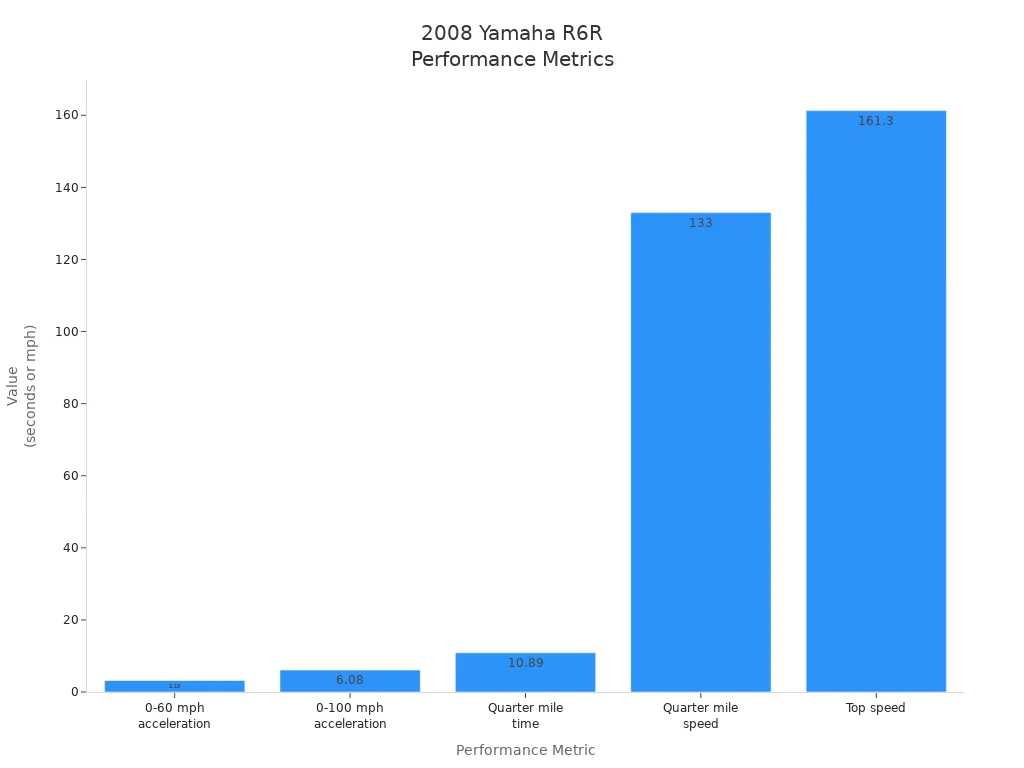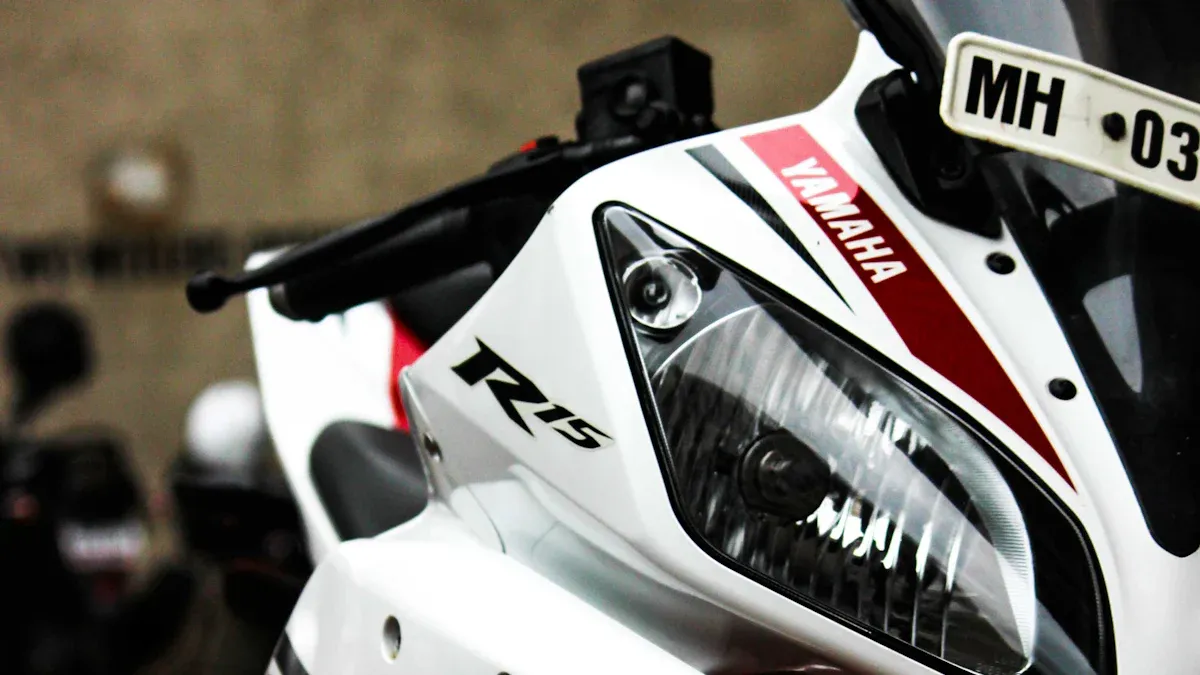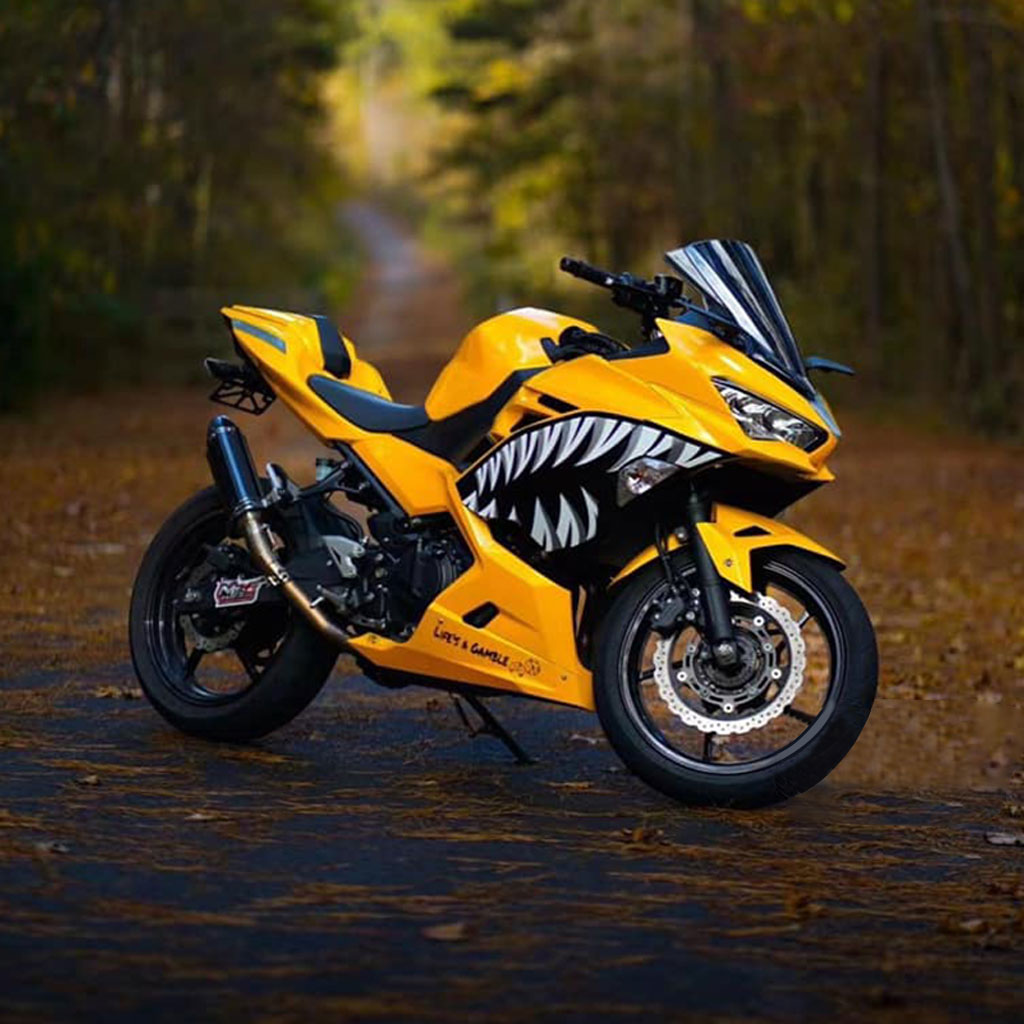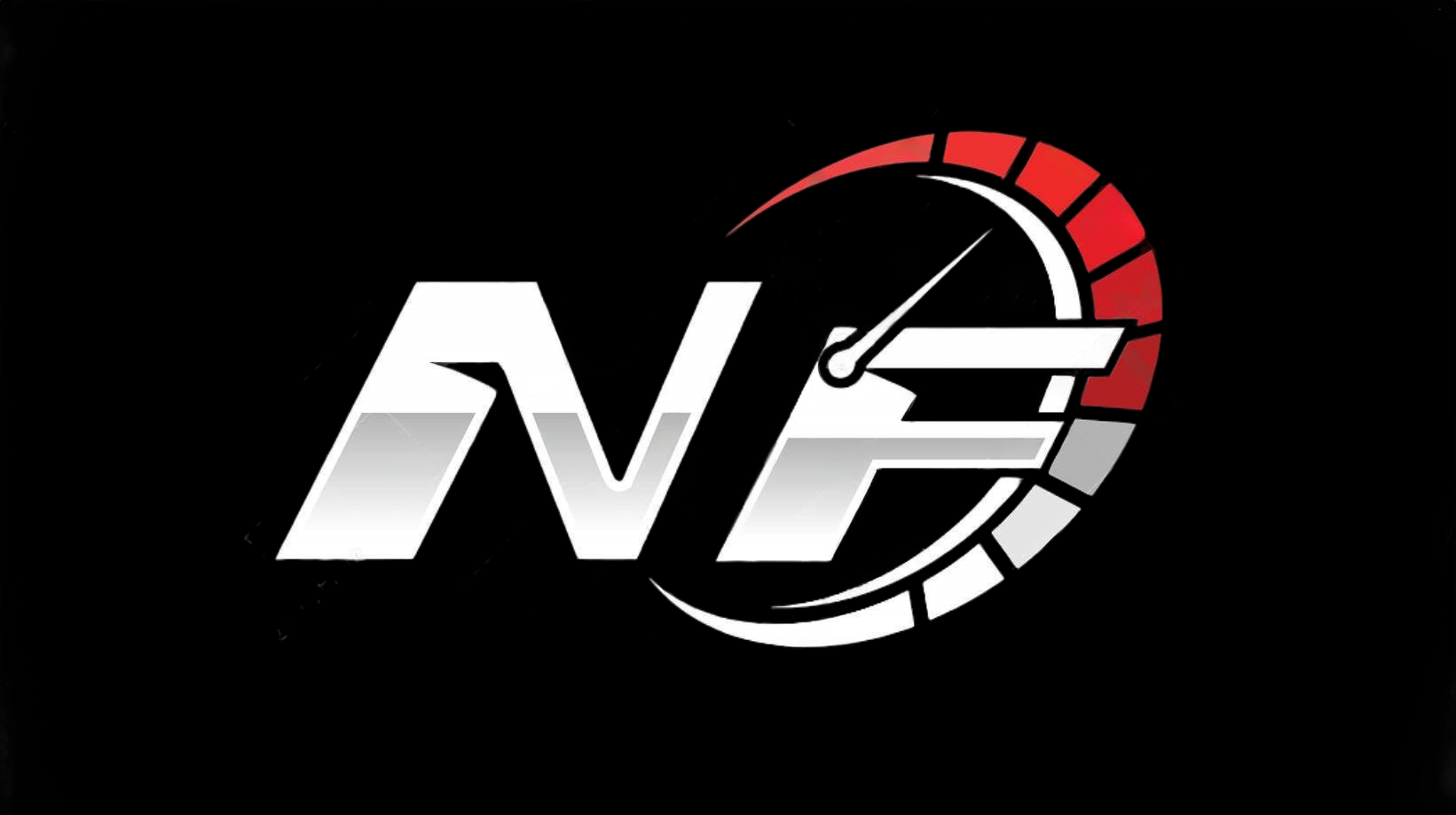2008 Yamaha R6R vs. R6: The Real Track Tale

You see the main difference between the 2008 yamaha r6r and the standard R6 in their focus. The R6R gives you a high-revving engine and sharp handling for the track. The standard R6 feels less aggressive but still performs well. You can swap most fairings and bodywork between these models with minor adjustments. Riders and experts agree that the 2008 yamaha r6r works best for track days. The standard R6 suits street riding better because of its easier power delivery.
2008 Yamaha R6R and Standard R6 Overview
2008 Yamaha R6R Highlights
When you look at the 2008 yamaha r6r, you see a bike built for the track. You get a high-revving engine that loves to scream at high RPMs. The frame feels stiff and light, which helps you take corners with confidence. The suspension setup gives you a firm ride, so you feel every bump and curve on the road. You also notice the aggressive riding position. This bike wants you to lean forward and focus on speed. Many riders choose the R6R for track days because it responds quickly to your inputs.
2008 Standard R6 Highlights
If you ride the standard R6, you find a machine that balances power and comfort. The engine still gives you strong performance, but it feels smoother at lower speeds. The seat feels a bit more forgiving, so you can ride longer without getting tired. The suspension works well for both city streets and twisty roads. You get a bike that handles daily rides and weekend fun with ease. The standard R6 gives you a good mix of excitement and comfort.
Side-by-Side Comparison Table
Here is a quick look at the main specifications for the 2008 Yamaha R6. These specs also apply to the R6R, since Yamaha did not release separate numbers for each model.
| Specification Category | Details |
|---|---|
| Model Name | YZF-R6 |
| Model Code | RJ15 |
| Engine Type | Water-cooled, 4-stroke, DOHC, 4 Valve |
| Displacement | 599 cc |
| Maximum Output | 123.7 ps (92.3 kW) @ 14,000 rpm |
| Maximum Torque | 6.65 kg·m (65.2 N·m) @ 11,000 rpm |
| Fuel Supply | Fuel Injection |
| Fuel Tank Capacity | 17.3 liters |
| Dry Weight | 166 kg |
| Curb Weight | 188 kg |
| Dimensions (L x W x H) | 2040 mm x 705 mm x 1100 mm |
| Seat Height | 850 mm |
| Front Tire | 120/70ZR17 58W TL |
| Rear Tire | 180/55ZR17 73W TL |
| Front Suspension | Telescopic Fork, 41 mm diameter |
| Rear Suspension | Swing Arm |
| Front Brake | W Disc |
| ABS | Not Available |
| Drive System | Chain |
| Seating Capacity | 2 |
Tip: When you compare these specs, you see that both bikes share the same core features. The real difference comes from how each model feels when you ride it.
2008 Yamaha R6R Detailed Specifications
Engine and Power Output
You get a unique engine setup when you ride the 2008 yamaha r6r. The engine uses a 600cc liquid-cooled inline four-cylinder design. This setup gives you strong acceleration and a smooth power curve. The bore and stroke measure 65.5 mm by 44.5 mm. The compression ratio sits at 12.4:1, which means the engine does not push as hard as the standard R6. You notice the difference in power output. The standard R6 reaches up to 135 PS at 14,500 rpm with direct air induction. The R6R does not match this peak, but you still feel plenty of power for spirited riding.
Here is a table that shows how the engine specs compare:
| Specification | 2008 Yamaha R6 (Standard) | 2008 Yamaha R6R (R6S) |
|---|---|---|
| Engine Type | 599cc liquid-cooled, 4-stroke, DOHC, 16-valve | 600cc liquid-cooled inline 4-cylinder, DOHC, 16-valve |
| Bore x Stroke (mm) | 67.0 x 42.5 | 65.5 x 44.5 |
| Compression Ratio | 13.1 : 1 | 12.4 : 1 |
| Maximum Power | 99.6 kW (135 PS) @ 14,500 rpm | Lower than R6 (implied) |
| Redline RPM | 16,000 rpm | N/A |
| Fuel Injection | Mikuni 41mm throttle bodies, twin injectors | 40mm throttle bodies |
| Valve Material | Titanium valves | N/A |
| Engine Features | YCC-T, YCC-I, ceramic composite liner-less | Standard DOHC inline-4 |
| Dry Weight (kg) | 166 kg | 162 kg |
Note: The standard R6 engine uses advanced technology like Yamaha Chip Controlled Throttle and Intake. You get titanium valves and a higher redline. The R6R engine feels more conventional, with a lower compression ratio and less peak power. You still get reliable performance for track and street use.
Chassis and Frame
You feel the difference in the chassis and frame when you ride these bikes. The standard R6 uses a GP-inspired Deltabox aluminum frame. This frame combines plates and castings for light weight and agility. The engine connects the headstock to the swingarm pivot, which saves weight and keeps the bike slim. You notice how the frame design helps you control the bike on twisty roads.
The 2008 yamaha r6r received a frame modification. Yamaha increased the frame flexibility and reinforced the swingarm. These changes reduce flex and improve handling. You get a bike that feels stable and responsive, especially when you push hard on the track.
- The standard R6 frame uses a straight connection layout for agility.
- The R6R frame tweaks focus on flexibility and swingarm strength.
- Both bikes use the engine as a structural part of the chassis.
Tip: You get better rider control and agility with these frame designs. The R6R changes help you handle corners with more confidence.
Suspension and Brakes
You rely on the suspension and brakes to keep you safe and comfortable. The standard R6 uses a telescopic fork with a 41 mm diameter in the front. The rear suspension uses a swing arm. You get a firm ride that helps you feel the road and respond quickly to changes. The R6R also uses a similar suspension setup, but Yamaha improved the components for better handling.
You find dual disc brakes in the front and a single disc in the rear. These brakes give you strong stopping power. You can trust them when you ride fast or need to slow down quickly. The suspension and brakes work together to give you control and confidence, whether you ride on the street or the track.
Callout: Always check your suspension and brakes before each ride. Good maintenance keeps your bike safe and performing at its best.
Electronics and Features
You get a modern set of electronics and features when you ride the 2008 Yamaha R6R. Yamaha designed this bike to give you more control and better performance on the track and street. The R6R uses a digital multi-function display. You can see your speed, engine RPM, fuel level, and gear position at a glance. The display also shows you the temperature and trip meters, which help you plan your rides.
Yamaha added advanced fuel injection to the R6R. This system gives you smooth throttle response and helps the engine run efficiently. You also get a 6-speed transmission with a close-ratio gearbox. This setup lets you shift quickly and keep the engine in its power band. The ignition system uses a transistor-controlled unit, which gives you reliable starts every time.
Here are some key features you will find on the 2008 Yamaha R6R:
- Digital LCD instrument panel with backlight
- Adjustable front and rear suspension
- High-performance fuel injection system
- 6-speed close-ratio transmission
- Lightweight aluminum frame
- Powerful dual front disc brakes
Tip: You can adjust the suspension settings to match your riding style. This feature helps you get the best performance on the track or a smoother ride on the street.
Performance Metrics
You want to know how fast the 2008 Yamaha R6R can go and how it performs in real-world tests. Yamaha built this bike for speed and quick acceleration. The R6R uses a 599cc liquid-cooled engine that produces up to 125.3 horsepower at 14,500 rpm. You feel the power when you twist the throttle.
The bike accelerates from 0 to 60 mph in about 3.0 to 3.2 seconds. You reach 100 mph in just over 6 seconds. The quarter mile takes about 10.7 to 10.9 seconds, with a top speed of around 160 to 161 mph. These numbers show you that the R6R stands among the fastest bikes in its class.
Here is a table that shows the main performance metrics for the 2008 Yamaha R6R and the standard R6:
| Metric | 2008 Yamaha R6R / R6 |
|---|---|
| 0-60 mph | 3.0 - 3.2 seconds |
| 0-100 mph | 6.08 seconds |
| Quarter Mile | 10.67 - 10.89 seconds |
| Quarter Mile Speed | 130.79 - 133 mph |
| Top Speed | 160 - 161.3 mph |
| Horsepower | 125.3 hp @ 14,500 rpm |
| Torque | 59.4 N·m @ 11,500 rpm |
| Engine Displacement | 599.4 cc |
| Compression Ratio | 12.8:1 - 13.1:1 |
| Wet Weight | 190 kg (419 lbs) |
You can also see these numbers in the chart below. The chart shows how the R6R accelerates and reaches top speed compared to other bikes in its class.

Note: The 2008 yamaha r6r gives you race-level performance. You get quick acceleration, high top speed, and strong braking. These features make the R6R a favorite for riders who want to push their limits on the track.
2008 Yamaha R6R Fairing Compatibility

Fairing Design and Mounting Points
You notice that the fairings on the 2008 Yamaha R6R and the standard R6 look almost identical at first glance. Both bikes use a sharp, aerodynamic design that helps you cut through the air. The fairings cover the engine and frame, protecting important parts from wind and debris. You find mounting points along the frame, under the seat, and near the headlight. These points use hex bolts, plastic rivets, and clips to hold the panels in place.
The fairing design on the 2008 yamaha r6r uses strong ABS plastic or, in some cases, carbon fiber for lighter weight. You see that the mounting points line up well between the R6R and the standard R6. This makes swapping panels easier, but you may need to make small adjustments for a perfect fit. The headlight cowl, side panels, and tail fairings all attach with a mix of bolts and push pins. You should always check the alignment before tightening everything down.
Tip: Always keep track of the bolts and clips you remove. Mixing up hardware can make reassembly harder.
Swapping Fairings Between R6R and R6
You can swap most fairings between the R6R and the standard R6. The main panels, such as the side fairings, upper cowl, and tail section, share similar shapes and mounting locations. You may need to adjust the fit by drilling new holes or adding washers, especially if you use aftermarket or carbon fiber fairings. Some riders find that the indicator and headlight wiring may need slight rerouting.
When you start the swap, you should:
- Remove four hex bolts on each side of the bike and keep them safe.
- Undo the plastic rivets on the side fairings with a Phillips head screwdriver.
- Push the fairings forward to release them from the frame.
- Disconnect the indicators before removing the lower fairings.
- Take out the bolts and rivets holding the lower panels.
- Remove the hex bolts for the headlight cowl and upper panels, watching for clips and electrical connections.
- Take off the windscreen by undoing four bolts and remove the mirrors by taking out two bolts.
- Disconnect the electrical cables to the headlights and remove screws as needed.
- For the tail fairings, take off the seats, pull pins, hex bolts, Allen bolts, push pins, and Phillips screws.
- Disconnect electrical connections and remove the battery tray bolts to release the light assembly.
- Remove the pillion pegs to free the final lower fairing.
- Reinstall the fairings by reversing these steps.
You should always test-fit each panel before tightening bolts. This helps you spot any gaps or misalignments early.
Practical Tips for Fairing Replacement
You want your fairing swap to go smoothly. Using the right tools and techniques makes a big difference. Here are some tips to help you:
- Use hand tools, like an Allen wrench set, to screw bolts on carbon fiber fairings. This prevents damage to the material.
- Wear safety goggles and gloves to protect yourself from sharp edges and debris.
- Keep a Dremel kit and a silicon carbide grinding stone bit nearby. You may need to trim or adjust mounting holes for a perfect fit.
- Handle carbon fiber fairings with care. They can crack more easily than ABS plastic.
- Store all bolts, clips, and screws in labeled containers. This keeps you organized during reassembly.
- Take photos as you remove each panel. These pictures help you remember where each part goes.
- If you notice a panel does not line up, try adding washers or gently enlarging the mounting holes.
- Always reconnect electrical cables before finishing the job. Double-check that all lights and indicators work.
Note: Minor modifications are common when swapping fairings between models or using aftermarket parts. Patience and careful work help you get the best results.
2008 Yamaha R6R Real-World Implications
Track Performance
When you take the 2008 yamaha r6r to the track, you notice some key differences in handling compared to the standard R6.
- The standard R6 uses inverted forks and radial-mounted brakes. These features give you sharper handling and better stopping power during aggressive riding.
- The 2008 R6R has standard forks and co-axial mounted brakes. This setup feels less precise when you push hard on corners.
- The handlebars on the R6R sit higher, above the triple tree. On the standard R6, the bars are lower. This changes how the bike feels when you lean into turns.
- Many riders say the R6R still feels close to earlier R6 models for most riding. You only notice the biggest differences when you ride at high speeds or on a race track.
Tip: If you want the best handling for track days, the standard R6 gives you a slight edge.
Street Riding Experience
You find the 2008 yamaha r6r comfortable for daily rides. The higher handlebars help you sit more upright, which reduces strain on your wrists and back. The suspension feels firm but not harsh, so you can handle city bumps and rough roads. The engine gives you smooth power, making it easy to ride in traffic or on highways. You get a sporty feel without giving up comfort.
- The R6R works well for both short trips and longer rides.
- You can enjoy spirited riding on twisty roads.
- The bike feels stable and easy to control at lower speeds.
Maintenance and Parts Availability
You will not struggle to find replacement parts for the 2008 yamaha r6r or the standard R6. Many suppliers offer aftermarket fairing kits, brake and clutch levers, wheels, sprockets, and more. These parts fit well and often come with extra accessories like windshields or tank pads. You can choose from different colors and styles to match your taste.
| Product Category | Available for 2008 Yamaha R6R |
|---|---|
| Brake & Clutch Levers | Yes |
| Brakes & Wheels | Yes |
| Chain & Sprockets | Yes |
| Suspension & Handling | Yes |
| Styling Accessories | Yes |
| Exhausts | Yes |
| Filters & Fuelling | Yes |
| Crash Protectors | Yes |
Note: You can keep your bike running smoothly and looking sharp because parts are easy to find in most markets.
You see clear differences between the 2008 yamaha r6r and the standard R6. The R6R gives you sharper track performance, while the standard R6 offers more comfort for street riding. You can swap most fairings between these models with only minor adjustments. Experts suggest choosing the R6R if you want the latest features for competitive track use. Many riders upgrade with ECU tuning, exhausts, and cooling systems to boost performance. If you ride mostly on the street, the standard R6 fits your needs well.
FAQ
Can you swap fairings between the 2008 Yamaha R6R and standard R6?
Yes, you can swap most fairings between these models. You may need to make small adjustments for a perfect fit. Always check the mounting points and test-fit panels before tightening bolts.
Which model works better for track days?
You get sharper handling and more advanced features with the standard R6. This makes it better for track days. The R6R still performs well, but you notice the difference when you push hard on corners.
Is the 2008 Yamaha R6R good for daily street riding?
You find the R6R comfortable for daily rides. The higher handlebars help you sit upright. The engine gives you smooth power. You can ride in traffic or on highways without feeling tired.
Are parts and accessories easy to find for both models?
You can find many parts and accessories for both the R6R and standard R6. Many suppliers offer fairings, levers, wheels, and more. You can keep your bike running and looking good without much trouble.
What upgrades improve the 2008 Yamaha R6R for track use?
You can upgrade the ECU, exhaust, and cooling system for better track performance. Many riders also adjust the suspension. These changes help you get more power and sharper handling on the track.
See Also
Kawasaki ZX-6R Fairings: Street Style Versus Racing Design
Key Features That Make The 2025 Yamaha R7 Unique
Top Yamaha R6 Fairing Kits Reviewed For Style And Power

